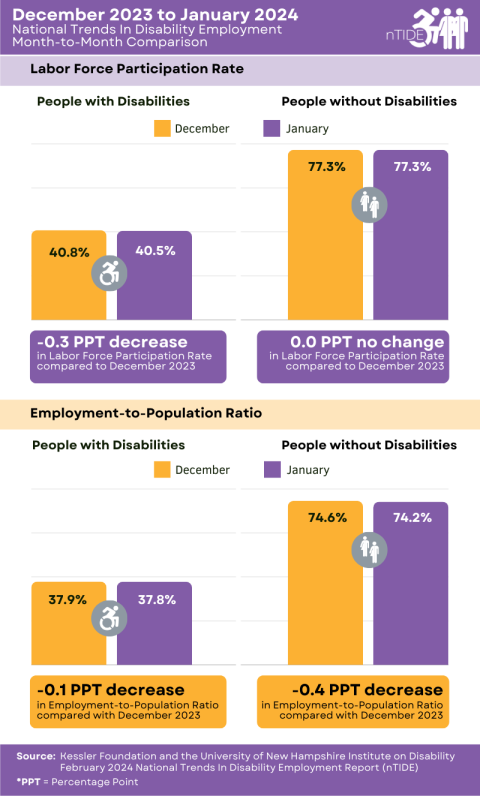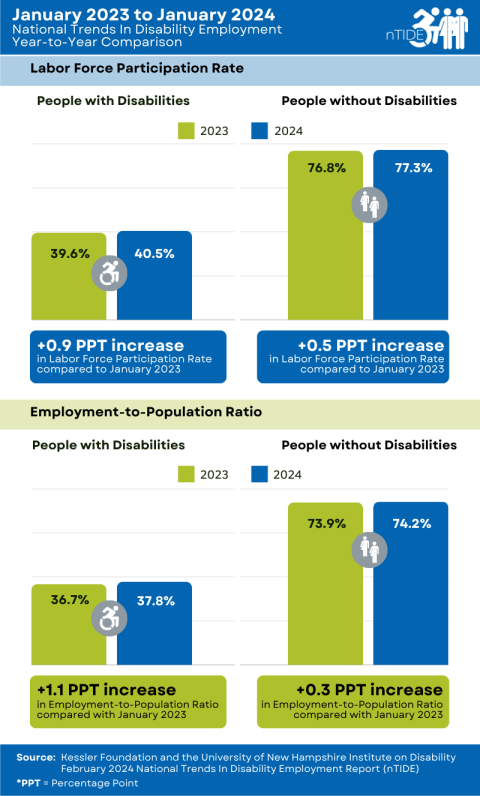
Join us for the next nTIDE Lunch & Learn Webinar featuring guest presenters Yonatan Ben-Shalom and Monica Farid from Mathematica.
nTIDE January 2024 Jobs Report: Despite minor shifts, employment for people with disabilities remains near historic highs
National Trends in Disability Employment (nTIDE) – Issued semi-monthly by Kessler Foundation and the University of New Hampshire
February 2, 2024 – Labor market indicators showed slight declines over the last two months for both people with and without disabilities, according to today’s National Trends in Disability Employment – semi-monthly update (nTIDE), issued by Kessler Foundation and the University of New Hampshire’s Institute on Disability (UNH-IOD). These declines may reflect the end of seasonal employment and the impact of the Federal Reserve’s anti-inflationary measures aimed at minimizing the risk of recession. Despite these shifts, employment for people with disabilities remains near historic highs.
Month-to-Month nTIDE Numbers (comparing December 2023 to January 2024)

This graphic compares the labor market indicators for December 2023 and January 2024, showing a slight decrease in the labor force participation rate and employment-to-population ratio for people with disabilities. Both indicators also declined slightly for people without disabilities.
Based on data from the U.S. Bureau of Labor Statistics (BLS) Jobs Report released today, the employment-to-population ratio for people with disabilities (ages 16-64) decreased from 37.9 percent in December 2023 to 37.8 percent in January 2024 (down 0.3 percent or 0.1 percentage points). For people without disabilities (ages 16-64), the employment-to-population ratio decreased from 74.6 percent in December 2023 to 74.2 percent in January 2024 (down 0.5 percent or 0.4 percentage points).
The employment-to-population ratio, a key indicator, reflects the percentage of people who are working relative to the total population (the number of people working divided by the number of people in the total population multiplied by 100).
“The employment-to-population ratio for people with disabilities has declined slightly over the last two months for people with and without disabilities, which differs from what we saw in 2023 when this metric continued to rise month over month for people with disabilities,” said John O’Neill, PhD, director of the Center for Employment and Disability Research at Kessler Foundation. “These declines may be a sign of the soft landing that the Federal Reserve was hoping to achieve without sending the economy into recession,” added Dr. O’Neill. “Even with these slight shifts, it is important to note that employment for people with disabilities remains near historic highs.“
The labor force participation rate for people with disabilities (ages 16-64) decreased from 40.8 percent in December 2023 to 40.5 percent in January 2024 (down 0.7 percent or 0.3 percentage points). For people without disabilities (ages 16-64), the January 2024 labor force participation rate remained unchanged from 77.3 percent in December 2023. The labor force participation rate reflects the percentage of people who are in the labor force (working, on temporary layoff (on furlough), or actively looking for work in the last four weeks) relative to the total population (the number of people in the labor force divided by the number of people in the total population multiplied by 100).
“Although the employment numbers show two months of minor decreases in the labor force participation rate of people with disabilities, this could be reflective of variation due to seasonal employment,” said Megan Henly, PhD, research assistant professor at UNH-IOD. “These trends look similar to the population without disabilities and are still higher than a year ago.”
Year-to-Year nTIDE Numbers (comparing January 2023 to January 2024)

This graphic compares the labor market indicators for January 2023 and January 2024, showing increases in the labor force participation rate and the employment-to-population ratio for people with and without disabilities.
Compared to this time last year, the employment-to-population ratio for people with disabilities (ages 16-64) increased from 36.7 percent in January 2023 to 37.8 percent in January 2024 (up 3 percent or 1.1 percentage points). For people without disabilities (ages 16-64), the employment-to-population ratio also increased from 73.9 percent in January 2023 to 74.2 percent in January 2024 (up 0.4 percent or 0.3 percentage points).
Likewise, the labor force participation rate for people with disabilities (ages 16-64) increased from 39.6 percent in January 2023 to 40.5 percent in January 2024 (up 2.3 percent or 0.9 percentage points). For people without disabilities (ages 16-64), the labor force participation rate also increased from 76.8 percent in January 2023 to 77.3 percent in January 2024 (up 0.7 percent or 0.5 percentage points).
In January, among workers ages 16-64, the 6,309,000 workers with disabilities represented 4.2 percent of the total 148,835,000 workers in the U.S.
Ask Questions about Disability and Employment
Each nTIDE release is followed by an nTIDE Lunch & Learn online webinar. This live broadcast, hosted via Zoom Webinar, offers attendees Q&A on the latest nTIDE findings, provides news, updates from the field, and features invited panelists who discuss current disability-related findings and events.
On February 2, 2024, at 12:00 pm – 1:00 pm Eastern, guest presenters Yonatan Ben-Shalom, PhD, principal researcher, and Monica Farid, PhD, both from Mathematica, joins Drs. O’Neill and Henly. Join our free Lunch & Learn live or visit the nTIDE archives at: ResearchonDisability.org/nTIDE. Also, register now for our mid-month Deeper Dive into employment trends at nTIDE Deeper Dive – 02/16/2024.
